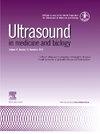Predicting Benign and Malignant Subpleural Pulmonary Lesions With a Nomogram Model Using Clinical and B-Mode Ultrasound Parameters
IF 2.6
3区 医学
Q2 ACOUSTICS
引用次数: 0
Abstract
Objective
To develop and validate an individualized nomogram for distinguishing between benign and malignant subpleural pulmonary lesions (SPLs) using B-mode ultrasound imaging and clinical data.
Methods
A total of 425 patients with SPLs were enrolled and classified into two groups: 220 patients were diagnosed with malignant lesions, and 205 with benign lesions. Patients were randomly assigned to a development cohort (DC, n = 297) and a validation cohort (VC, n = 128) in a 7:3 ratio. Statistical analyses included rank-sum tests and chi-square tests. Boruta analysis was used to identify key features associated with malignant SPLs. The multivariable logistic regression model based on independent malignant SPL factors was developed and represented as a nomogram. The model's performance was assessed in terms of discrimination, calibration and clinical utility.
Results
Six variables were selected to construct the nomogram: age, pack-year of smoking, air bronchogram, the angle between the lesion border and the thoracic wall, posterior echo of the lesion and visceral pleural invasion. The area under the receiver operating characteristic curve for the model was 0.859 (95% CI: 0.816–0.901) in the DC and 0.862 (95% CI: 0.800–0.923) in the VC. Calibration curve analysis demonstrated that the nomogram closely aligned with the ideal curve, reflecting its good calibration. Furthermore, decision curve analysis, clinical impact curve (CIC) and net reduction curve (NRC) further confirmed the model's favorable clinical utility.
Conclusion
We have developed a nomogram that serves as an effective tool for assessing malignant SPLs. This model holds significant promise as a complementary diagnostic aid, particularly in primary healthcare settings and bedside examination.
应用临床及b超参数的Nomogram模型预测胸膜下肺良恶性病变。
目的:利用b超影像和临床资料,建立并验证胸膜下肺良恶性病变的个体化形态图。方法:共纳入425例SPLs患者,分为两组:恶性病变220例,良性病变205例。患者按7:3的比例随机分配到发展队列(DC, n = 297)和验证队列(VC, n = 128)。统计分析包括秩和检验和卡方检验。使用Boruta分析来确定与恶性SPLs相关的关键特征。建立了基于恶性SPL独立因素的多变量logistic回归模型,并以正态图表示。该模型的性能在区分、校准和临床效用方面进行了评估。结果:选取年龄、吸烟包年、支气管空气谱、病变边界与胸壁夹角、病变后回声、内脏性胸膜侵犯6个变量构建nomogram。模型的受试者工作特征曲线下面积在DC为0.859 (95% CI: 0.816-0.901),在VC为0.862 (95% CI: 0.800-0.923)。标定曲线分析表明,该图与理想曲线基本一致,具有良好的标定效果。决策曲线分析、临床影响曲线(CIC)和净减少曲线(NRC)进一步证实了该模型具有良好的临床实用性。结论:我们已经开发了一种nomogram,可以作为评估恶性SPLs的有效工具。这种模式具有重要的承诺,作为一种补充诊断援助,特别是在初级卫生保健设置和床边检查。
本文章由计算机程序翻译,如有差异,请以英文原文为准。
求助全文
约1分钟内获得全文
求助全文
来源期刊
CiteScore
6.20
自引率
6.90%
发文量
325
审稿时长
70 days
期刊介绍:
Ultrasound in Medicine and Biology is the official journal of the World Federation for Ultrasound in Medicine and Biology. The journal publishes original contributions that demonstrate a novel application of an existing ultrasound technology in clinical diagnostic, interventional and therapeutic applications, new and improved clinical techniques, the physics, engineering and technology of ultrasound in medicine and biology, and the interactions between ultrasound and biological systems, including bioeffects. Papers that simply utilize standard diagnostic ultrasound as a measuring tool will be considered out of scope. Extended critical reviews of subjects of contemporary interest in the field are also published, in addition to occasional editorial articles, clinical and technical notes, book reviews, letters to the editor and a calendar of forthcoming meetings. It is the aim of the journal fully to meet the information and publication requirements of the clinicians, scientists, engineers and other professionals who constitute the biomedical ultrasonic community.

 求助内容:
求助内容: 应助结果提醒方式:
应助结果提醒方式:


